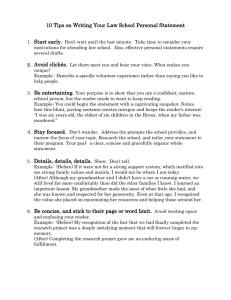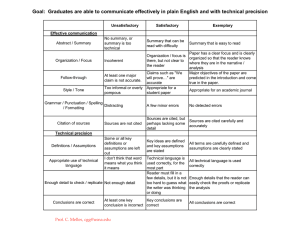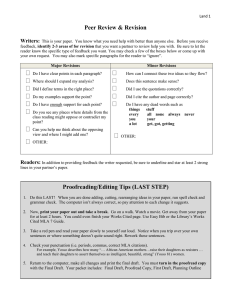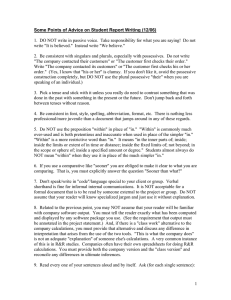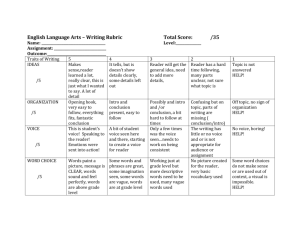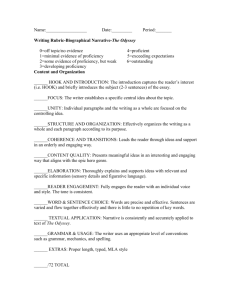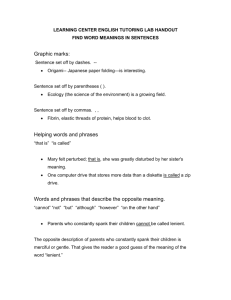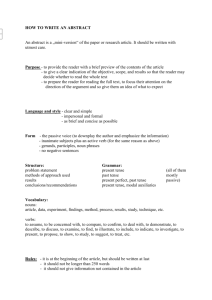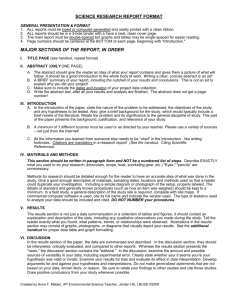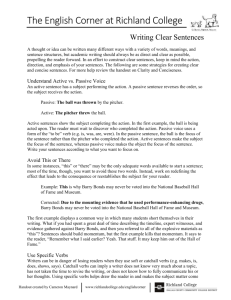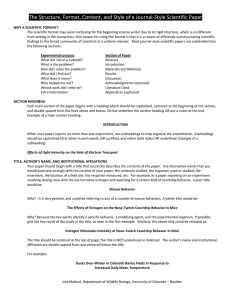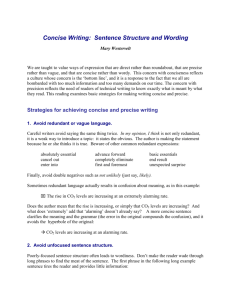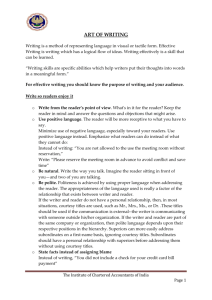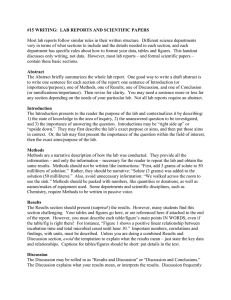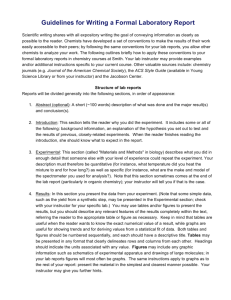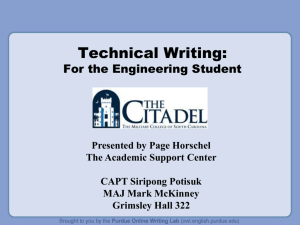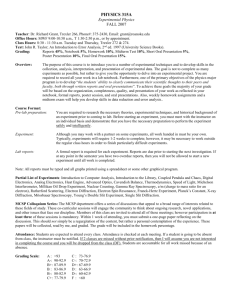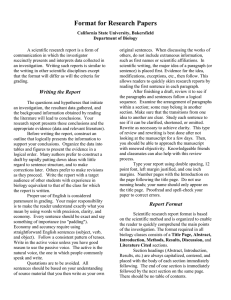Scientific Writing MHS Science Doc.pmd
advertisement
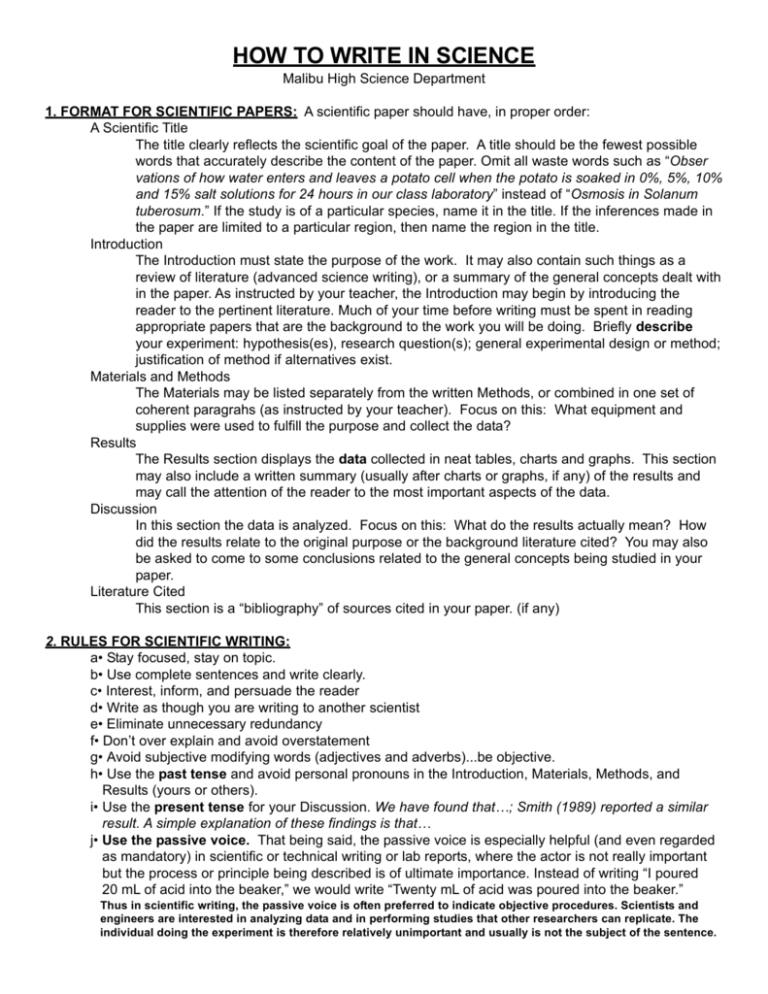
HOW TO WRITE IN SCIENCE Malibu High Science Department 1. FORMAT FOR SCIENTIFIC PAPERS: A scientific paper should have, in proper order: A Scientific Title The title clearly reflects the scientific goal of the paper. A title should be the fewest possible words that accurately describe the content of the paper. Omit all waste words such as “Obser vations of how water enters and leaves a potato cell when the potato is soaked in 0%, 5%, 10% and 15% salt solutions for 24 hours in our class laboratory” instead of “Osmosis in Solanum tuberosum.” If the study is of a particular species, name it in the title. If the inferences made in the paper are limited to a particular region, then name the region in the title. Introduction The Introduction must state the purpose of the work. It may also contain such things as a review of literature (advanced science writing), or a summary of the general concepts dealt with in the paper. As instructed by your teacher, the Introduction may begin by introducing the reader to the pertinent literature. Much of your time before writing must be spent in reading appropriate papers that are the background to the work you will be doing. Briefly describe your experiment: hypothesis(es), research question(s); general experimental design or method; justification of method if alternatives exist. Materials and Methods The Materials may be listed separately from the written Methods, or combined in one set of coherent paragrahs (as instructed by your teacher). Focus on this: What equipment and supplies were used to fulfill the purpose and collect the data? Results The Results section displays the data collected in neat tables, charts and graphs. This section may also include a written summary (usually after charts or graphs, if any) of the results and may call the attention of the reader to the most important aspects of the data. Discussion In this section the data is analyzed. Focus on this: What do the results actually mean? How did the results relate to the original purpose or the background literature cited? You may also be asked to come to some conclusions related to the general concepts being studied in your paper. Literature Cited This section is a “bibliography” of sources cited in your paper. (if any) 2. RULES FOR SCIENTIFIC WRITING: a• Stay focused, stay on topic. b• Use complete sentences and write clearly. c• Interest, inform, and persuade the reader d• Write as though you are writing to another scientist e• Eliminate unnecessary redundancy f• Don’t over explain and avoid overstatement g• Avoid subjective modifying words (adjectives and adverbs)...be objective. h• Use the past tense and avoid personal pronouns in the Introduction, Materials, Methods, and Results (yours or others). i• Use the present tense for your Discussion. We have found that…; Smith (1989) reported a similar result. A simple explanation of these findings is that… j• Use the passive voice. That being said, the passive voice is especially helpful (and even regarded as mandatory) in scientific or technical writing or lab reports, where the actor is not really important but the process or principle being described is of ultimate importance. Instead of writing “I poured 20 mL of acid into the beaker,” we would write “Twenty mL of acid was poured into the beaker.” Thus in scientific writing, the passive voice is often preferred to indicate objective procedures. Scientists and engineers are interested in analyzing data and in performing studies that other researchers can replicate. The individual doing the experiment is therefore relatively unimportant and usually is not the subject of the sentence. 2. RULES FOR SCIENTIFIC WRITING: (continued) k• Use the precise word: • Simpler words are preferred over complex words - use concrete words and examples • Simpler sentences are preferred over more complicated sentences In general, the best writing is simple and direct. Writing that is simple and direct is most easily understood. It also tends to be the most forceful and memorable. Use no more words than necessary, and never use a complicated word if a simpler one will do just as well. l• Aim for economy: (be parsimonius) - Use because instead of based on the fact that; - Use for or to instead of for the purpose of. 3. ADDITIONAL TIPS: a• Proofread your paper carefully; spell check does not catch everything; “there” is spelled correctly but not if you meant “their” b• Move from general to specific. c• Engage your reader: answer the questions, “What did you do?” “Why should I care?” d• Make clear the links between problem and solution, question asked and research design, prior research and your experiment. sources: Gopen, G. and J. Swan, The Science of Scientific Writing, American Scientist, Nov-Dec 1990. Tischler, M.E., Scientific Writing Booklet, Dept of Biochemistry and Molecular Biophysics, University of Arizona.
